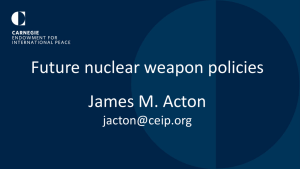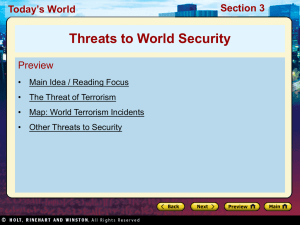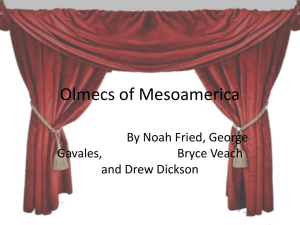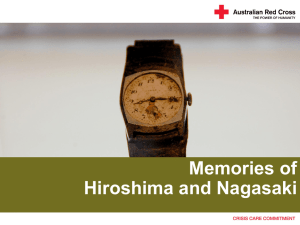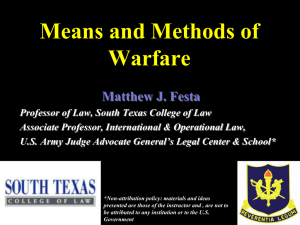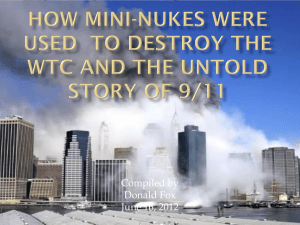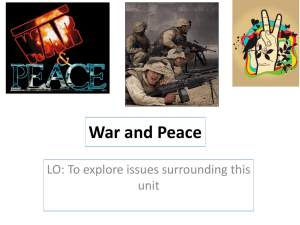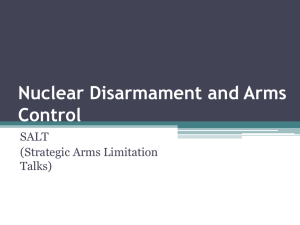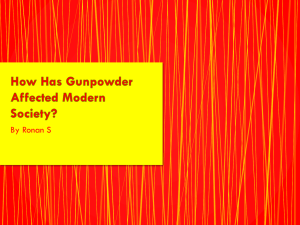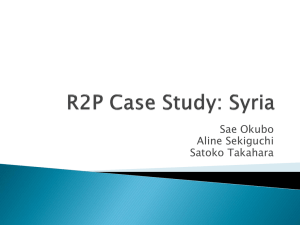Chapter 6
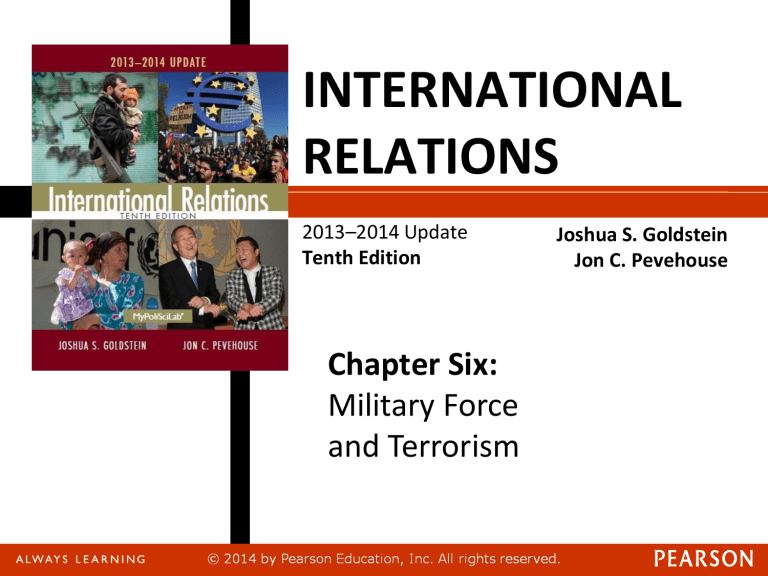
INTERNATIONAL
RELATIONS
2013–2014 Update
Tenth Edition
Joshua S. Goldstein
Jon C. Pevehouse
Chapter Six:
Military Force and Terrorism
Refugees flee new fighting near Goma, Democratic Congo, 2008
6.1 Conventional Forces
Land Forces: Controlling Territory
Naval Forces: Controlling the Seas
Air Forces: Controlling the Skies
Coordinating Forces: Logistics and Intelligence
Evolving Technologies
MyLab Media
Simulations:
Conflict: You are the President of the United States http://media.pearsoncmg.com/long/long_longman_media_1/
2014_mpsl_sim/ir/simulation.html?simulaURL=6
Please log into MyPoliSciLab with your username and password before accessing this link.
Land Forces and Naval Forces
Control of territory is fundamental to state sovereignty and is accomplished primarily with ground forces.
Small missiles and electronic warfare are increasingly important, especially for naval and air forces. The role of satellites is expanding in communications, navigation, and reconnaissance.
Air Forces
Air war, using precision-guided bombs against battlefield targets, proved extremely effective in the
U.S. campaigns in Iraq in 1991, Serbia in 1999,
Afghanistan in 2001, and Iraq in 2003.
WINNING HEARTS AND MINDS
Counterinsurgency warfare has become central to the missions of uniformed military forces worldwide. The U.S. military rewrote its counterinsurgency manual and changed its tactics in Iraq and
Afghanistan to emphasize political and economic activities and positive relations with civilian populations. Here, in the capital of Somalia, a
Ugandan soldier with the African Union force works on befriending local children after the AU ousted Islamist militants from the city, 2012.
PROJECTING POWER
Different types of military forces are adapted to different purposes. Aircraft carriers are used for power projection in distant regions, such as in the Afghanistan and Iraq campaigns.
President of the United
States,
Barack Obama
SMALL IS BEAUTIFUL
The information revolution is making smaller weapons and smaller dispersed units more potent. A “revolution in military affairs” is driving changes in U.S. military strategy, including the expanding use of unmanned drones. This insect-sized drone shown in 2011 could collect real-time intelligence in complex urban environments.
6.1 Conventional Forces
Q: In conventional forces, __________.
A) infantry, armor, and blacksmiths are part of armies
B) marines move to battle in ships but fight on land
C) the minority of soldiers are involved in logistics
D) electronics, especially radar, are relied on most by artillery
Answer:
B) Marines move to battle in ships but fight on land
True-False:
The most fundamental and traditional purpose of conventional forces is to take, hold, or defend territory.
Answer:
True
6.2 Terrorism
Political violence
Purpose
Primary effect is psychological
Classic cases, 1970s-2001
Persistence is puzzling
More willing than states are to violate the norms of the international system
State-sponsored terrorism
ASYMMETRICAL CONFLICT
Terrorist attacks often reflect the weakness of the perpetrators and their lack of access to other means of leverage. Terror can sometimes amplify a small group’s power and affect outcomes. Al Qaeda’s September 11, 2001, attacks, staged by a relatively small nonstate actor, ultimately led to the withdrawal of U.S. troops from Saudi Arabia, drew the United States into a counterinsurgency war in Iraq, and brought al Qaeda itself a surge of recruits for new attacks worldwide.
6.2 Terrorism
Q: Which of the following is characteristic of terrorism?
A) Acts of terrorism kill hundreds of thousands of people every year.
B) The primary effect of terrorism is psychological.
C) Terrorists are acting to gain leverage against nonstate actors.
D) Terrorists acts are typically random acts with no clear goal in mind.
Answer:
B) The primary effect of terrorism is psychological.
True-False:
Those cases in which a nonstate actor utilizes violence against civilians by secret nonuniformed forces, operating across international borders, as leverage against state actors are considered classic cases of terrorism.
Answer:
True
6.3 Weapons of Mass Destruction
Nuclear Weapons
Ballistic Missiles and Other Delivery Systems
Chemical and Biological weapons
Proliferation
Nuclear Strategy and Arms Control
MyLab Media
Video. Iran’s Nuclear Ambitions http://media.pearsoncmg.com/long/long_mpsk_vcs_1/vcs3_
14_irans_nuclear_ambitions.html
Please log into MyPoliSciLab with your username and password before accessing this link.
Nuclear Weapons
Distinguished from conventional weapons by their enormous potential lethality
Fission vs. Fusion
NUKE IN A BOX
Nuclear weapons were invented during World War II and used on two
Japanese cities in 1945. Tens of thousands have been built, and nine states now possess them. Obtaining fi ssionable materials is the main difficulty in making nuclear weapons. Terrorists’ efforts to obtain them pose a grave threat. Here, in 1999, a U.S. congressman displays a mock-up of the Sovietbuilt nuclear “suitcase bomb” that, in the wrong hands, could kill hundreds of thousands of people.
Ballistic Missiles & Other Delivery Systems
Strategic and tactical
Ballistic missiles
Cruise missiles
Chemical & Biological Weapons
How they work
Effects
Delivery systems
Efforts to control use
VULNERABLE
Civilians are more vulnerable to chemical weapons than soldiers are. A treaty aims to ban chemical weapons worldwide. Here, Israeli kindergarteners prepare against a chemical warfare threat from Iraqi
Scud missiles during the Gulf War, 1991.
Proliferation
Implications
Forms of proliferation
Efforts to inhibit or prohibit proliferation
SOMETHING TO HIDE
The most important hurdle in making nuclear weapons is access to fissionable materials (plutonium and uranium). Iran’s enrichment of uranium could give that country nuclear bombs within the decade.
Fueling Western suspicions, Iran has not been forthcoming with international inspectors. Iran bulldozed this large site and removed its topsoil in 2004 before letting inspectors in. In 2006 and 2007, the
UN Security Council applied mild sanctions against Iran over its refusal to stop enriching uranium
Nuclear Strategy & Arms Control
First strike, second strike
Mutually assured destruction
Defense
Arms control treaties
The U.S. and Russian presidents sign thick arms control treaty, 2010.
DEFENSIVE MOVE
The nuclear arms race between the superpowers during the Cold War led to strategies and arms control agreements that helped develop norms and expectations about nuclear weapons and missiles. India and Pakistan have followed a similar arms race, leading to mutual deterrence. Recently, defense against missiles has begun to enter the strategic calculus. Here,
Israel’s new “Iron Dome” system shoots down short-range missiles from
Gaza in 2012.
THE WAR IS OVER
U.S. and Russian nuclear forces were greatly reduced in the 1990s.
Here, U.S. B-52 bombers are being chopped up, under the eye of
Russian satellites, to bring force levels down.
6.3 Weapons of Mass Destruction
Q: How do strategic weapons compare to tactical weapons?
A) Strategic weapons are short-range weapons, whereas tactical weapons are long-range weapons.
B) Strategic weapons are long-range weapons, whereas tactical weapons are short-range weapons.
C) Strategic weapons are integrated into air, sea, and land forces using delivery systems such as artillery shells and land mines, whereas tactical weapons are carried mainly on missiles.
D) Theft or accidents are a concern regarding strategic weapons, but not tactical weapons.
Answer:
B) Strategic weapons are long-range weapons, whereas tactical weapons are short-range weapons.
True-False:
Shock pulse is an effect of a nuclear explosion.
Answer:
False
6.4 States and Militaries
Military Economics
Control of Military Forces
Civil Military Relations
Military Economics and Control of Military Forces
Arms imports and exports - imports by states in the global South make up more than half of all arms sales.
Chain of command - except in times of civil war, state leaders—whether civilian or military—control military forces through a single hierarchical chain of command.
TAKING OVER
Through a hierarchical chain of command, states control the actions of millions of individual soldiers, creating leverage in the hands of state leaders. But armed forces still sometimes defy civilian control. Here, soldiers in Mali stage a coup (2012) that unwittingly sparked an Islamist takeover of half the country and then a French military intervention.
Civil-Military Relations
Military governments and coup d’etat
Civilian control
Covert operations
Private contractors
6.4 States and Militaries
Q: CIA covert operations in the 1950s overthrew governments unfriendly to the United States in __________.
A) Cuba and Vietnam
B) Iran and Guatemala
C) Korea and South Africa
D) Romania and Iraq
Answer:
B) Iran and Guatemala
True-False:
The choices about military capabilities that leaders have to make include how much to spend on military capabilities.
Answer:
True
Chapter Discussion Question
Military forces include a wide variety of capabilities suited to different purposes. Why does conventional warfare require different kinds of forces than those needed to threaten the use of nuclear, chemical, or biological weapons? Further, why is control of territory so crucial to some, and why is it typically accomplished primarily with ground forces?

